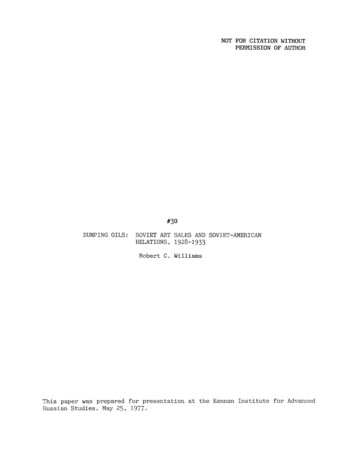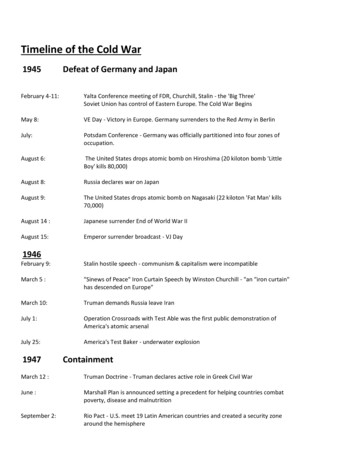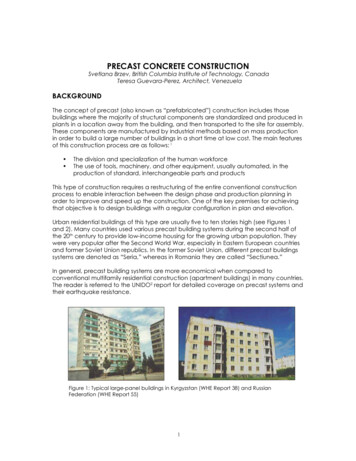
Transcription
ECRE'F(b) (3)-P.L.86-361Early History of the Soviet MissileProgram (1945-1953)How ir evolved, inirial German influence0:eJr che end of \\'orld 'X'ar II. che Red Armv movedinto eascern Germam and capcured V-1 and V-2 missilesices. rockecs. supporcing svscems and facilicies. and mJmof the German scientists who had developed these andocher special 1.l.eapons svsrems. 'X'ith the acquisition ofthese facilities. che weapons themselves. and the scientistsand engineers who had developed them. the USSRquicklr acquired che nucleus of ics own missile program.Firsc used agai nsc London in June 1944. che V-1 wasan effective weapon svstem. le inflicted severe damageand casualcies on Greac Britain. and particularly London.in che latter pare of the war. at the same time significanclycurrailing war.time production in the London area. Ir alsoposed a serious problem co· the Allied invasion of Europe.The Allies found it necessary to place high priorities oncouncering this threat. diverting aircraft from support oftheir invading armies to attacks on V-1 sites andsupporting facilities. The V-1- and the V-2-werealso used effectively against cities and pore facilities on theconrinenr after liberation by Allied forces. Antwerp, inparticular. suffered severe damage from massive attacksby these missiles. and the V-1 in particular.(b) (3)-P.L.12 -SEeJtEI'""86-36The Wasser/all, a German surface-to-air missile, was captured by the Soviets at the end ofWorld War II.1'1Af4f'L! YIA COJolll4l Cl"IAf4fQl!L! Of4Ll
--·- - -. ---- ---·--·-------------Si:CR:ETItI f·l. The German HS 293 air-to-surface missile was used effectively against Allied ships. Over 2,000 wereproduced by the Germans during the war, of which about 200 were used operationally.Thousands of these V-1 "buzz bombs"' were ubsequenrly launched against Britain, and against targets.in Europe as well, until Allied forces on the continent·: ' . :- f9 ced it back out of range. A cigar-shaped monoplane,;';·. the V-1 flew at subsonic speeds, and was designed for·. eap and fast production, some even using wooden. - 1ngs. It could be launched from either ground sites or.aircraft. Being subsonic and subject to incercepcion by:;'::. nti-aircraft guns and aircraft (though its high speeds. ?Ced capabilities of the interceptors to their limits),, thousands were destroyed before reaching their targets. ny others malfunctioned and crashed. But severalo. nd got through.'1 : i1The V-2 presented a far more serious problem thanthe V-1. Being a ballistic weapon, it could not beintercepted. Nor could its guidance system be jammed, asit was electronically guided only during ascent. Deployedagainst Great Britain three months afrer the V-1 wasfirst used, it caused grave concern among Allied leaders.With a warhead weighing 2,000 pounds, a range ofabout 200 miles, speeds in excess of one mile a second,and invulnerability to interception or jamming. it was1 Named Aggreg.,te 4 (A 4) in 1941, ic was the fourth in a seriesof tescs of this cype of missile begun in Germany in the early 1930s.During the War, it became known as the V-2, the second in the seriesof Hitler's "reprisal" weapons.I h'ttf:BLE VIA EOlwflf YT el fJ\iJfz(f!L] ettlt 1-sECREJ'"" 13
. !CRETtruly a formidable weapon: It, and the V-1, were aptlynamed: the "V" stemming from the wordVergeltungswaffe, or "reprisal weapon."When the Soviets captured German test facilitiescoward che end of the war, their main interest wasunderstandably in the V-2. But they also gainedknowledge of a number of ocher German weaponssystems either under development or operational. Inaddition co the V-1 and V-2, the Soviets capturedweapons for air-to-air, air-to-surface, and surface-to-airuse.Two of these, both air-to-surface missiles, had beendeveloped by the Germans in the lace 1930s and were used successfully against ships during the war. One, theFX-1400 (called the FRITZ-X), in 1943 sank the35,000-ton Italian battleship Roma. It went down withina half-hour of two direct hits by FRITZ-X missiles.During che same year, in che Dodecanese Islandscampaign in the Aegean Sea, the Germans sank sevenAllied destroyers in two days using an air-to-surfacemissile called the HS 293. Both were captured by theSoviets at the end of che war.Information about other German research-anddevelopment projects was also obtained by the Soviets.along with some of the equipment. For example, duringthe war the Germans had developed a submarine-towedbarge for launching V-2s. Although never operationallyreseed, ics purpose was the cowing of a V-2 in a barge to apredetermined stop for firing. Boch the submarine andthe barge were to crave! co the launching site submerged,and once there, the barge would be floated to the surfaceand upended, by flooding, into a vertical firing position.Vulnerability of the submarine while cowing the barge,possible rough seas disrupting fueling and launch, anddesign limitations of che V-2, made this concept a riskyone at best. Bur it proved to be the forerunner ofSoviet-as well as U.S.-submarine-missile systems ofthe future, and the U.S. and the USSR proved thefeasibility of the concept when they launched V-ls fromsurfaced submarines soon after the war.Thus, by the end of the war, the Germans had madeimpressive progress in the special weapons area, and inresearch and development of advance concepts. This fact· was not lost on the Soviets-nor on the Allies-and theUSSR quickly took advantage of the availability of thesemen and equipment, even before hostilities had ended.Everything available-men, missiles, supporting systems, associated eleccronics, factories, and everythingelse of value-quickly found their way into Soviethands.14 C::lt!TSoviet Exploitation of World War IIAcquisitionsInitial Efforts in GermanyAfter the war, the Soviets at first tried to salvage theremainder of Hitler's missile organizations and facilities,and, more or less, co keep the in intact on German soil.This approach was first noted in 1945, when theyestablished lnscicuce Rabe in Bleicherode, East Germany.Included in this organization ere many of the scientistswho ha developed the V-weapons, and it was here thatthe Germans were given the primary task of documentingthe V-2 program for the USSR. This effort producedderailed studies on such subjects as stability theory,ballistics and aerodynamics, accepcance specifications,manufacturing directions and procedures, operationaldeployment and use by military uni nd evaluations andapplications of test insrrumen for use in rhemanufacturing process.In addition to documenting the V-2 program, theSoviets investigated and exploited ocher facets of cheGerman war-time missile effort. Sites and factories werecarefully studied, some of which were also utilized by theSoviets in a number of missile-related functions.corresponding closely to their missions during the war.One, for example, was involved with air-co-surfacemissiles, such as the previously mentioned HS 293.Another, a former German V-2 repair facility, wasconverted by the Soviets into a V-2 assembly area. Stillanother, containing test stands for V-2 power units, wasused for the same purpose by the Soviets. And anotherwas used to study and evaluate surface-to-air missileguidance systems worked on there during the war.Forced Exodus from Germany to the USSRIn October 1946, some of the German missilespecialists departed for the USSR, most against th i wi J.This group of Germans was told they would be hvmg inthe Soviet Union for periods up to five years, but somewere co scay ac least eight years. With their departure,missile installations and factories were disassembled andshipped to the Soviet Union. This was done despite thefact that the Soviets had carefully organized, repaired,and, in some cases, rebuilt these facilities after the war.This first group, estimated to be about 50 in number,was sent to the Scientific Research Institute (NII) 88,located at Kaliningrad. They were subsequenclyorganized into four groups. These groups, each with aIINIBLE VIA E9blUIT Eili\flPIEJ::S 9Plb-Y
,,!!. :.II.r it)The FX-1400 (o"r FRITZ-X) was a German air-to-surface missile. le sank the Icalian batcleship Roma"during the war.Soviet chief. were named ( l) the Guidance and ControlGroup, the Power Pia nr Group. ( 3) the Design andDrafting Group. and ( 4) the Schmetterling Group. 2 The· man in charge of the Germans as a group was himself a: ::German named Groettrup, whose specialty was high · -frequency electronics. He had established a close workingrelationship with the chief Soviet engineer at NII 88.,,. · For their first six months in the Soviet Union, theAeilih i:,.::.- . Germans continued documenting their war-time' .::; :programs, a continuation of rhe studies begun at Jt ' ···. .2TheSchmetterling wasaGermansurface-co-air missile.·A.'t ppro 1macely 50 were reconscrucced and subsequendy rested in che. ·.USSR In the summer of 1948.;;:·,,.(I"i 'Qh:h Vl:*o EOl llPITBleicherode. Again, primary emphasis was placed on theV-2. But no significant modifications were apparentlymade to the missile during this period, nor previous to itsfirst launch on Soviet soil in October 1947.Final preparations for these initial tests had begun amonth earlier at Kapustin Yar, the first missile-test rangein the Soviet Union. Located about 100 kilometers east ofStalingrad (lacer renamed Volgograd), Kapustin Yar wasused for these and subsequent tests of the V-2s. Thisinitial series was completed by December 1947, duringwhich period 12 missiles were fired co distances ofapproximately 225 kilometers. Some of these V-2s hadbeen assembled at Bleicherode by che Germans fromElls'z J JELS8NLYS!Cltf'f'15
.--SECRET"parts left over after the war; others used newlymanufactured pares and were assembled by the Soviets.The Soviet Union had apparencly acquired about 2 V-2s from the Germans. Exaaly how many theythemselves manufactured later on cannot be preciselydetermined. But a German specialise named Muennich,who had seen production parts for a pilot series of V-2sat a research facility at Novaya (NII 885), estimated thatas many as 100 of these missiles were scheduled forproduction there. Also, the Soviets apparentlymanufactured V-2 components until at least 1951.By the early 1950s, the Soviets had exploited theGermans to the fullest possible extent, while at the sametime satisfying themselves chat they could continue theeffort on their own; only then did the Germans begin·departing the Soviet Union. By 195 3, most had returnedto Germany, except for a few who had been involved withmissile-guidance systems, an area char was apparenclygiving the Soviets special problems. This group wasdetained until at least 1956. And long after the Germansdeparted the Soviet Union, reflections of their effortswere seen in the evolving Soviet missile program.The Expanding Soviet Missile ProgramBy the time the Germans had left the Soviet Union.the USSR had developed a highly significant capability ofits own. staffed by competent personnel. Although smallin numbers when the Germans first arrived in the USSR.and possessing almost no practical experience. these Sovietscientists and engineers steadily acquired awareness of.and knowledge about, inherent problems and derail.Overlap with the Germans also afforded them the necessary on-the-job exposure, and. as the Germans themselves lacer noced, "this group advanced with astonishing rapidity" thereafter. 3 Following the initial V:. 2 tests at Kapuscin Yar in lace1947, the 50 or so Germans at NII 88 again moved. Thistime they went to Gorodomlya Island in Lake Seliger,near Ostashkov. Located about midway between Moscowand Leningrad, the Gorodomlya Island facility wasknown as Branch l of NII 88. The island's isolationafforded an excellent location for classified operations.The move to Gorodomlya Island ended direct German3The Germans, while in the USSR, were isolated to themaximum extent possible from parallel or evolving Soviet programs.and, indeed, from projects outside their areas of responsibility workedby other German groups. Thus, precisely when, and to what extent,the Soviets themselves developed certain weapons systems in theseearly years is not always possible to discern. Nor can lines be finelydrawn separating Soviet and German involvemenr in particular projects during these early years, independent of or in conjunction witheach other.16SECRE'f'involvement at NII 88 in Kali.ningrad; apparently theSoviets believed they could continue work there on theirown.By 1948, it is estimated that between 350 and 400German missile specialists were working in the SovietUnion, a significant increase over che 50 scienciscs whohad first arrived in late 1946. About half of chis Germanwork force was located at Branch l of NII 88. It washere that the Germans bc:Came deeply involved indesigning and developing a successor co the V-2-calledthe R-10-and in ocher prognms that were to follow.the R-11 through R-15.Foll iwing some initial organizational and designproblems, the R-1 O project was approved by che Sovietsin l 948. They already had a head scarr on developmentof this missile. for the Germans had done somepreliminary research and development on an improvedversion of the V-2 during che laccer part of the war. Butthis work was interrupted bv Sovi,armies before ic hadprogressed verv far. Points co be si:i\iised in desi,enin,1! anddeveloping the R-10 missile were ( 11 improved accuracv.( 2l a less complicated propulsion S\'Stem. ( 3 l increJseJrange. and (4l cheaper production techniquesThe R-10 project was slow co evolve. AlthtiU,l!h irsdesign scages occupied the Germans for most of cwo vears.in 1949 it remained a "paper projecc.·· Even in l 9'51.when German involvement in this and other project ended because of suddenly imposed security restrictions. itwas still estimated co be years away from actualdeployment. At that time. Dr. Magnus. a top Germanscientist. escim.ated chat lengthv periods of testing wouldbe required before the missile could be mass-producedand operationally deployed. Nevertheless. the R-10project yielded a missile-at least in design -chac wasmuch improved over the V-2. le was capable of longerrange. carried a heavier payload. was lighter. andincorporated a number of other technical refinements thatenhanced its overall performance-particularly in themissile-guidance area. But so far as the Germans wereaware, chis missile did not progress beyond the "workproject" phase. 4 Scages in chese missile-design projects were clearly defined andlabeled. They were designated as preliminary. sketch. and workprojects. The preliminary work project required a brief reporc of I 0 to20 pages, outlining the overall project in very general terms anddescribing what it was expected to accomplish. The sketch, orintermediate, project, usually evolved into a study of several hundredpages and calkd for fairly specific descriptions and drawings of theoverall missile configuration, showing, in considerable detail,component parts and their applications to the overall system. The workproject stage called for detailed descriptions and drawings of che entiresystem. It was to be in sufficient derail to permit factories to buildcomponent parts and assemble the missile in its final form.lJ i'oNQbl! "IA E9ffIPJT EllAHHELS 9NLY
-r·d: .·!. .-S e1tEr.differing variations. The third, the R-13, was mainly theresponsibility of the Germans. But this effort, and, so faras the Germans were aware, the other two as well, hadadvanced only to the intermediate stage by the timeGerman involvement ended in 195 l. when the Sovietsimplemented their security restriaions.Although these projects apparently did not produceweapons systems, they nevertheless did provide afoundation upon which t]ie Soviets could base futuremissile programs. Many troublesome technical problems.had been extensively studied, and, to a significant degree,overcome, at least on paper. Also, these efforts affordedthe oviet scientists and technicians the initial experiencethe1 sorely needed in these early years of involvement inan unfamiliar field.Before direct German involvement in speci fie projectsended in l 951, they had worked on two other Sovietmissile svstems-the R-14 and R-15. The first of these,--·i!".!"f::;io-'··'- ·· h:.·The V-2, developed and used by che Germans.,.!.in World War II, was the first missile launched in· ,the Soviec Union after che war. le was first fired by· ·the Soviets in October 1947. Its launching inaugu·-:rated the opening by the USSR of ics firsc missile '.t t facility at Kapustin Yar.- ;: everalother Soviet missile programs evolved during.;·nus period, but these programs, with one exception (the. ; iR- 4), apparently did not progress beyond intermediate e s1gn stages. :· , hr e e of these - the R- 1 l , R- 1 2, and.:; 13- probably incorporated multi-stage design. The.!! the R-11 (also called che KOROLEV rocket), was. arendy initiaced as a parallel Soviet project· to che .7 0.· Another, the R-12, incorporated a variety of.,,.esigns and innovations, producing a number of widely. .A V-2 rocket being launched at Peenemunde,the major German test facility during World WarII.4.··": :lh'l!iBLE 'il1\ JfsflN'f t:fh\lJNELS ONLYSECR T17
.-SEC:ft:f:Tthe R-l4. was described in one reporc as a "scaled-upversion of the KOROLEV project/R-10 endeavors.·· Irwas designed as a single-stage rocket. 77 feet in kngthand 12. 5 feet in diameter ar its base. With a range of1.600 nautical miles. ir was initially designed ro carry apavload of 6.600 pounds. but this was later cur by 30percent. indicari ng-according to the Germans-anuclear warhead. Another significant aspect of the R-14project was the design of these missiles so char they couldbe launched from silos-the beginning of the USSR'smissile.silo programs of the future.Bur rhe R- l 4 project was marked by haste. and. so faras rhe Germans were aware. did not progress beyond rhework project phase. Work began about late 1949. -andconcluded with completion of the work phase in thesprint: of l 950. Thus. as was rhe case with the R- l 0.research and Jevelopmem through rhe work project phasehad been completed on paper. but actual production ofthe R-14 did nm materialize. at least while the Germ:inswere involved.The last Soviet missile project in which the Germanswere involved was the R-l 5. Despite much work on chepart of the Germans in designing this missile (which wassaid to be a project initiated and vigorously supported byStalin himse!O. it reached only the intermediate or sketchproject stage of development. Labeled a "cruise·· missile.it was designed co combine boch the V-1 and V-2missiles into one system. the V -2 carrying a V-1 to analtirude of 12- lmilis, where the.l would belaunched toward the target. The range was planned co beover 3. 700 statute miles, with a speed of 1,300 miles anhour and a warhead of th-ree tons. The Germans doubtedthe practicality of the system from the beginning. and. asn ted previouslv. it did not develop bevond theintermediate design stage.With the completion of the Germans· involvement inthese projects. their work in the Soviet missile programended. after nearly a decade of effort. Of the weaponssvstems the Germans were in ved with. not one. so faras the Germans were aware as acru:.dh· produced orJeploved br the Soviets while they were in the L7SSR.SV-The V-1, or "buzz bomb," inflicted severe damage and casualties on Great Britain and other targetsduring the war. It was first used against London in June 1944, and thousands were launched in the lastfew months of the war.18 iCRE'f'HANDLe y IA COfofH4T (;'.fj;\NNELS 0NLY
ECRETBut these missile projects, and especially the R-10 andR-14, laid the groundwork for future Soviet programs.The Germans provided the USSR a solid base upon whichto expand, and, in so doing, enabled the Soviets to leapyears ahead of what otherwise would have been the -case.From this early German assistance, and with technologygleaned from Western sources in subsequent years, theSoviet Union progressed rapidly throughout the years inthe missile area, culminating in their advanced systems oftoday .(b) (3)-E'.L.86-36.,.,-·.,,.,-ii --·.fiL.:.·r-·HANQIF y1 'O'fl JT 'll'PltJELS 8NLY-SECRET19
Early History of the Soviet Missile Program (1945-1953) How ir evolved, inirial German influence 0:eJr che end of \\'orld 'X'ar II. che Red Armv moved into eascern Germam and capcured V-1 and V-2 missile sices. rockecs. supporcing svscems and facilicies. and










